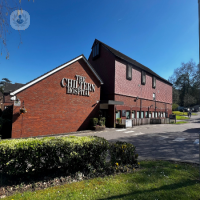What is revision knee replacement surgery?
Revision knee replacement surgery revisits existing knee replacements, sometimes replacing previous implants. These implants, typically made out of plastic, are inserted between the shin bone and the thigh bone.

Why would you need revision knee replacement surgery?
Revision knee replacement surgery is sometimes needed because the implant can cause instability, possibly due to being placed incorrectly. This can cause the patient to feel wobbly whilst walking. Revision surgery is also needed when the implant is worn down, over time, and surgery swaps out the old implant for a new one. Surgery will also be needed if existing implants become detached from the bone.
What does revision knee replacement surgery involve?
Depending on the type of revision knee surgery being carried out, the procedure will differ. These procedures are carried out with regional or general anaesthetic. During revision knee replacement surgery, a surgeon replaces the old device with a new one.
Revision surgery is more complicated than a primary (or initial) total knee replacement (TKR) and entails many of the same risks. It is a longer, more complex procedure that requires extensive planning, and specialised implants and tools to achieve a good result.
In some cases, only one implant or component of the prosthesis has to be revised. Other times, all three components — femoral, tibial, and patellar — need to removed or replaced and the bone around the knee needs to be rebuilt with augments (metal pieces that substitute for missing bone) or bone graft. A revision procedure is typically more complex than the original knee replacement surgery because the surgeon must remove the original implant, which would have grown into the existing bone.
In addition, once the surgeon removes the prosthesis, there is less bone remaining. In some instances, a bone graft — transplanting a piece of bone transplanted from another part of the body or from a donor — might be required to support the new prosthesis.
What does recovery from a revision knee replacement procedure involve?
After surgery, patients will usually stay in hospital for between three to five days. Crutches are usually needed for two to three weeks following surgery, after which a walking stick can be used for support.
During recovery, physical therapy is recommended so that strength and movement is restored to the knee. Sufficient painkillers can be prescribed, along with blood-thinning medication to prevent blood clots forming. It is important to get moving as soon as possible after the revision knee surgery has been carried out.
03-06-2018 08-01-2023Revision knee replacement
Professor Lee Jeys - Orthopaedic surgery
Created on: 03-06-2018
Updated on: 08-01-2023
Edited by: Conor Lynch
What is revision knee replacement surgery?
Revision knee replacement surgery revisits existing knee replacements, sometimes replacing previous implants. These implants, typically made out of plastic, are inserted between the shin bone and the thigh bone.

Why would you need revision knee replacement surgery?
Revision knee replacement surgery is sometimes needed because the implant can cause instability, possibly due to being placed incorrectly. This can cause the patient to feel wobbly whilst walking. Revision surgery is also needed when the implant is worn down, over time, and surgery swaps out the old implant for a new one. Surgery will also be needed if existing implants become detached from the bone.
What does revision knee replacement surgery involve?
Depending on the type of revision knee surgery being carried out, the procedure will differ. These procedures are carried out with regional or general anaesthetic. During revision knee replacement surgery, a surgeon replaces the old device with a new one.
Revision surgery is more complicated than a primary (or initial) total knee replacement (TKR) and entails many of the same risks. It is a longer, more complex procedure that requires extensive planning, and specialised implants and tools to achieve a good result.
In some cases, only one implant or component of the prosthesis has to be revised. Other times, all three components — femoral, tibial, and patellar — need to removed or replaced and the bone around the knee needs to be rebuilt with augments (metal pieces that substitute for missing bone) or bone graft. A revision procedure is typically more complex than the original knee replacement surgery because the surgeon must remove the original implant, which would have grown into the existing bone.
In addition, once the surgeon removes the prosthesis, there is less bone remaining. In some instances, a bone graft — transplanting a piece of bone transplanted from another part of the body or from a donor — might be required to support the new prosthesis.
What does recovery from a revision knee replacement procedure involve?
After surgery, patients will usually stay in hospital for between three to five days. Crutches are usually needed for two to three weeks following surgery, after which a walking stick can be used for support.
During recovery, physical therapy is recommended so that strength and movement is restored to the knee. Sufficient painkillers can be prescribed, along with blood-thinning medication to prevent blood clots forming. It is important to get moving as soon as possible after the revision knee surgery has been carried out.


What is the difference between primary and revison knee replacements?
By Mr Koushik Ghosh
2024-11-21
Knee replacements are usually quite successful and can offer a new lease of life to the patient undergoing the procedure. However, sometimes a revision knee replacement will be necessary. In his latest online article, renowned orthopaedic surgeon Mr Koushik Ghosh explains this procedure in detail. See more


In the know about knee replacements
By Mr Stephen Veitch
2024-11-16
When a knee replacement is the only option, it's good to know that relief is more than likely it’s on its way - but it also may be nerve-wracking regarding to going through the operation. Here to discuss when the procedure is required, revision knee replacements and knee replacement success rate, as well as other interesting points, is leading orthopaedic hip and knee surgeon in Salisbury, Mr Stephen Veitch. See more


Considering knee replacement surgery? An expert answers your questions
By Mr Simon Hoskinson
2024-10-23
Revered consultant trauma and orthopaedic surgeon Mr Simon Hoskinson gives expert advice for patients considering knee replacement surgery in this detailed article. See more
Experts in Revision knee replacement
-
Mr Ghias Bhattee
Orthopaedic surgeryExpert in:
- Anterior cruciate ligament
- Meniscus
- Sports injuries
- Knee replacement
- Partial knee replacement
- Revision knee replacement
-
Mr James Donaldson
Orthopaedic surgeryExpert in:
- Hip replacement
- Knee replacement
- Robotic surgery
- Revision hip replacement
- Revision knee replacement
- Knee arthroscopy
-
Mr Sanjiv Manjure
Orthopaedic surgeryExpert in:
- Sports injuries
- Knee replacement
- ACL reconstruction
- Revision knee replacement
- Hip replacement
- Hip dysplasia
-
Mr Mark Dunbar
Orthopaedic surgeryExpert in:
- Knee replacement
- Partial knee replacement
- Anterior cruciate ligament
- Meniscus
- Revision knee replacement
- Knee arthroscopy
-
Mr Duncan Whitwell
Orthopaedic surgeryExpert in:
- Bone cancer
- Sarcoma
- Revision hip replacement
- Revision knee replacement
- Knee replacement
- Hip replacement
- See all

Pinnacle Global Healthcare
Pinnacle Global Healthcare
13 Lichfield Road
No existe teléfono en el centro.
By using the telephone number provided by TOP DOCTORS, you automatically agree to let us use your phone number for statistical and commercial purposes. For further information, read our Privacy Policy
Top Doctors

New Victoria Hospital
New Victoria Hospital
184 Coombe Lane West, Kingston upon Thames, KT2 7EG
No existe teléfono en el centro.
By using the telephone number provided by TOP DOCTORS, you automatically agree to let us use your phone number for statistical and commercial purposes. For further information, read our Privacy Policy
Top Doctors

The Chiltern Hospital - part of Circle Health Group
The Chiltern Hospital - part of Circle Health Group
London Rd, Great Missenden HP16 0EN
No existe teléfono en el centro.
By using the telephone number provided by TOP DOCTORS, you automatically agree to let us use your phone number for statistical and commercial purposes. For further information, read our Privacy Policy
Top Doctors
-
Pinnacle Global Healthcare
13 Lichfield Road, StaffordExpert in:
- Orthopaedic surgery
- Diagnostics
- Pain management
- Physiotherapy
- Sports Medicine
- Regenerative Medicine
-
New Victoria Hospital
184 Coombe Lane West, Kingston upon Thames, KT2 7EG, South LondonExpert in:
- Cardiology
- General Surgery
- Orthopaedic surgery
- Breast augmentation
- Pain management
- Spine
-
The Chiltern Hospital - part of Circle Health Group
London Rd, Great Missenden HP16 0EN, Great MissendenExpert in:
- Allergies Ophthalmological
- Clinical analysis
- Cancer
- Breast Cancer
- Skin Cancer
- Prostate Cancer
- Most viewed diseases, medical tests, and treatments
- Joint pain
- Lumbar herniated disc
- Spinal surgery
- Minimal access surgery (keyhole surgery)
- Shoulder pain
- Osteoporosis
- Botulinum toxin (Botox™)
- Abnormal gait
- Shoulder osteoarthritis
- DEXA scan








